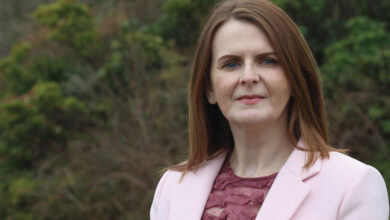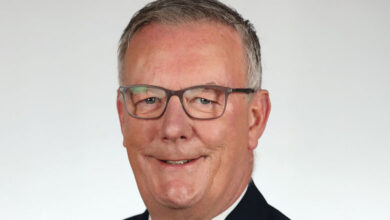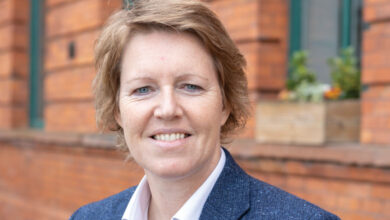Local Election 2023: Sinn Féin sweeps the board
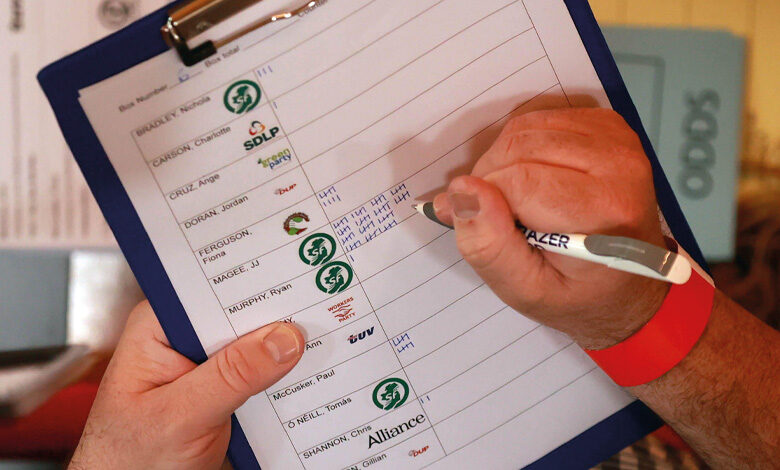
One year on from the Assembly elections, the local elections provided a new first in Northern Ireland politics; the first time nationalism has outpolled unionism. Joshua Murray was at the count centre in Belfast City Hall and reflects upon a landmark day of results.
Victory in the 2023 local elections belonged to Sinn Féin, with the party gaining votes on a scale seemingly unimagined even by those within the party. For unionism, this election marked a new low, finishing below nationalism in the popular vote for the first time in the history of Northern Ireland.
Although nominally about the governance of Northern Ireland’s 11 councils, these local election results have undoubtedly been decided on issues such as the lack of an Executive and the Northern Ireland Protocol.
The scale of Sinn Féin’s success cannot be overstated, with the party having surged by 7 per cent between the 2019 and 2023 elections, and now holding 144 of Northern Ireland’s 462 local government seats. This is the highest number of seats held by a single party since the formation of Northern Ireland’s super councils.
The election was also broadly successful for both the DUP and the Alliance Party. DUP members will be satisfied at having maintained the party’s 122 seats, and reasserted its dominance in unionist politics.
The DUP will be bolstered by the fact that it has, for the foreseeable future, seen off challenges from the UUP and TUV, with the party maintaining its 122 seats won in 2019. Whilst Jeffrey Donaldson MP’s position of leader is now seemingly unassailable, the decline of the overall unionist vote has opened a can of worms for unionism, with senior figures already calling for a realignment of unionist parties.
In the centre, it was a solid day for the Alliance Party, which made a steady gain of 14 seats, altough the party may be worried it has reached a ceiling of 13 per cent of the electorate.
For the SDLP and the Ulster Unionist Party, on the other hand, it was a repeat of what has been a decades-long trend of slow decline for the erstwhile leaders of the Executive. For Colum Eastwood MP, it was the sixth out of his seven elections fought as SDLP leader which saw the party record a decline in its vote share.
Doug Beattie MLA will have been encouraged by some promising results for the UUP in Derry and Strabane, but projections of how unionism adapts to its new surroundings of a Northern Ireland with a Catholic majority may mean the end for the UUP.
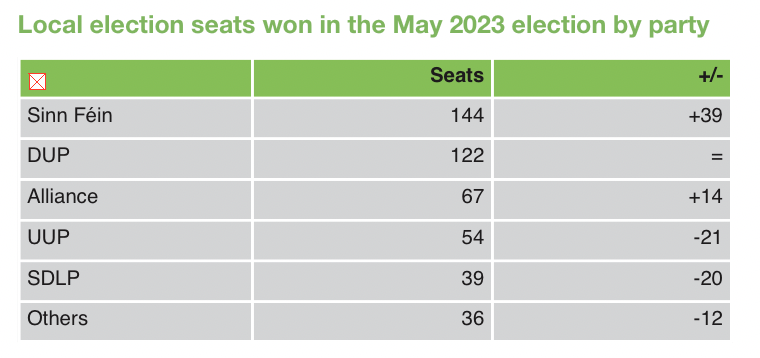
Sinn Féin domination
Not only did Sinn Féin win 144 seats, some 22 more than the DUP, but the party achieved a breakthrough that went beyond simply subsuming nationalist votes from the SDLP. In Derry City and Strabane, for instance, the party picked up seven seats. These gains were made from parties all across the political spectrum, including the SDLP, DUP, Alliance, People Before Profit, and Aontú.
Throughout Northern Ireland, the party won 30.1 per cent of the popular vote, giving it a surge of 7.7 percentage points from the 2019 local elections. The majority of this surge cannot be attributed to Sinn Féin sweeping traditional nationalist voters, as the SDLP, despite losing a number of seats, only lost 3.3 percentage points from its 2019 vote.
Indeed, contrary to the narrative of some commentators, this election is a potentially watershed moment, with parties in favour of a united Ireland outpolling pro-union parties by around 4 per cent.
Sinn Féin members, buoyed by their success, stated that the overwhelming sentiment behind their surge was the lack of an Executive in Stormont, with a sentiment of injustice at Michelle O’Neill MLA not being able to form an Executive as First Minister. “People were telling us that Michelle won fair and square and deserved her chance to be First Minister,” one member told agendaNi.
O’Neill’s personal popularity was a further undoubted factor in these election results, with Sinn Féin running a presidential style campaign centred around the Sinn Féin vice president. The most recent LucidTalk opinion poll showed O’Neill to have an approval rating of 41 per cent, the highest out of all party leaders in Northern Ireland.
With the party now represented in 10 of Northern Ireland’s 11 councils, including in some previously unlikely areas such as Lisburn, it is clear that Sinn Féin is now a party which appeals to voters across Northern Ireland outside of its traditional republican base. Whilst some commentators have asserted that ‘there is definitely a pro-union majority in Northern Ireland,’ this significant success for nationalism will be seen as a boost for those wanting a united Ireland.
Fundamental questions for unionism
“He now has the TUV monkey off his back,” was how one commentator described the fallout of the local elections for DUP leader Jeffrey Donaldson MP.
DUP members in Belfast were reasonably satisfied with the election results, with the party maintaining its figure of 122 councillors throughout Northern Ireland. Donaldson will be able to use this election result to present a public endorsement of his decision to boycott the Assembly to reform the Northern Ireland Protocol.
The DUP’s vote share between 2019 and 2023 declined by a marginal 0.9 per cent, and the party saw no net losses in its council seats. The DUP has asserted itself as the leader of unionism, whilst its rivals in the TUV only recorded a net gain of three seats, meaning that it won less seats in the 2023 local elections than it won in 2014. “Jim had his chance and failed,” remarked one DUP member.
What is clear from this election is that turnout was in the region of three percentage points lower in more traditionally unionist-leaning districts in Northern Ireland, which may have played a role in some of the gains made by nationalists and the Alliance Party. For instance, in the Waterside in Derry City and Strabane, Sinn Féin gained a seat from the DUP and there are a majority of nationalist councillors in the district.
This lower turnout suggests that, when unionists go out to vote, they still tend to support the DUP, but those dissatisfied about the lack of an Executive tended to not vote in this election. Furthermore, it is apparent that dissatisfaction with the DUP over its Stormont boycott had a galvanising effect amongst nationalists and contributed to the Sinn Féin surge.
Writing in the Sunday Independent, Sam McBride asserted that unionism needed to “learn lessons from nationalism” about adapting to the shift in demographics in Northern Ireland. In 2016, unionism under the then-popular Arlene Foster triumphed over a then-stagnant Sinn Féin due to apathy among nationalists over the party’s Executive record.
Unionism was able to benefit from reduced turnout among nationalists in that election but has since embarked on a run of elections where it has continually galvanised the nationalist vote, predominantly around Sinn Féin. Unionists like the DUP leader continually state their desire to “make Northern Ireland work,” however, boycotting the Assembly has fed into the perception that the DUP are doing the opposite.
If unionism’s ongoing decline is to be reversed, it is imperative that it takes on a leadership role in making Northern Ireland work, and central to this will be playing a role in governing the region.
The age-old debate of forming a vanguard unionist party is once again on the agenda, despite having been ruled out by Ulster Unionist leader Doug Beattie MLA. One of his predecessors, Mike Nesbitt MLA, articulated his belief that the UUP may not be able to continue, and has called for a single traditional unionist party which would encompass the DUP, TUV, and the right of the UUP, as well as a more liberal party which is explicitly unionist and can compete for votes with Alliance and soft nationalism.
These calls were echoed by former DUP leader Edwin Poots MLA, who called on unionists to “wake up and smell the coffee” amid the growth of the nationalist vote.
One element which the politicos have been adamant about is that the DUP will utilise its strength gained within unionism to go back to the Assembly, amid the perception that it has ‘seen off’ the TUV and UUP, with no credible electoral threats emerging for the party in the immediate future.
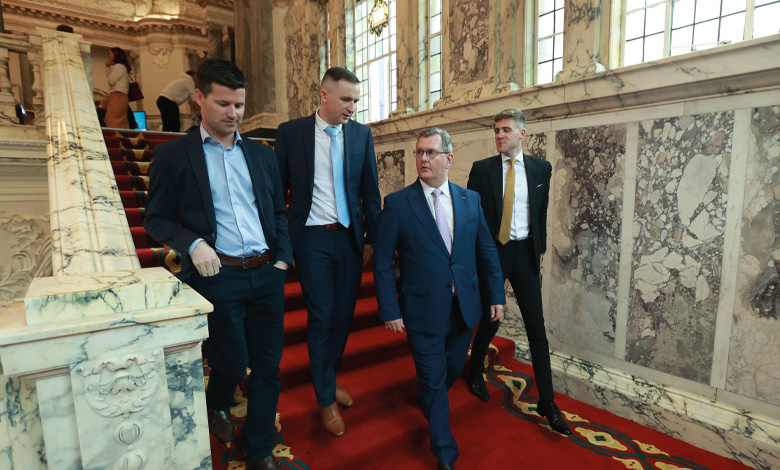
Marginal gains for Alliance
For the Alliance Party, the local elections were one of consolidation, with the party seemingly reaching a ceiling among the Northern Ireland electorate in the 13 per cent mark for now. This stagnation is driven by the disparity in results west of the Bann – where it scored in the region of 6 per cent – and east of the Bann, where the party won around 21 per cent of the vote.
The party was broadly successful against the Ulster Unionist Party but lost out to nationalism in Derry City and Strabane. Overall, the party will be satisfied in having translated its Assembly election success into local government, with Alliance now indisputably one of the three main parties.
What this means for politics
Northern Ireland now has a three-party system encompassing Sinn Féin, the DUP, and the Alliance Party, rendering the term ‘big five’ redundant.
Sinn Féin will seek to utilise these results as a springboard for elections in the Republic, where it aims to form a government at the next election and will have gained influence in the fight for Michelle O’Neill MLA to be able to become Northern Ireland’s first nationalist First Minister.
There will be a soul-searching exercise for unionism, with the creation of a vanguard unionist party seemingly unionists’ only hope of forming a larger party than Sinn Féin, unless unionists manage to find a way to reduce turnout among the nationalist electorate.

